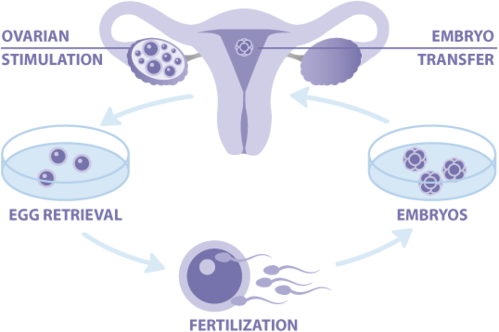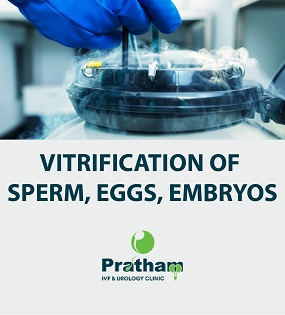
Pratham IVF And Urology
×
- Home
- about us
- services
In vitro fertilization (IVF) is the Mixing of a woman’s egg and a man’s sperm in a laboratory dish. In vitro means outside the body. Fertilization means the sperm has attached to and entered the egg.
Description
IVF is a form of assisted reproductive technology (ART). This means special medical techniques are used to help a woman become pregnant. It is most often tried when other, less expensive fertility techniques have failed.
There Are Five Basic Steps To IVF:
Step 1: Stimulation, also called super ovulation
Hormones (Gonadotropins), are given to the woman to boost egg production.
Normally, a woman produces one egg per month. Fertility drugs tell the ovaries to produce several eggs.
During this step, the woman will have regular transvaginal ultrasounds to examine the ovaries and blood tests to check hormone levels.
Step 2: Egg retrieval
A minor surgery, called follicular aspiration, is done to remove the eggs from the woman’s body.


The surgery is done as an outpatient procedure at our clinic most of the time. The woman will be given Mild anaesthesia so she does not feel pain during the procedure. Using ultrasound images as a guide, the health care provider inserts a thin needle through the vagina and into the ovary and sacs (follicles) containing the eggs. The needle is connected to a suction device, which pulls the eggs and fluid out of each follicle, one at a time.
The procedure is repeated for the other ovary. There may be some cramping after the procedure, but it will go away within a day.
In rare cases, a pelvic laparoscopy may be needed to remove the eggs.
The problem with IVF can be less percentage of fertilisation. With ICSI we are making sure that we inject one sperm in each egg and so fertilisation rate is supposed to be better with ICSI.
So there shouldn’t be a standard protocol for IVF or ICSI to be done, it should be decided by embryologist in the best interest of the patient.
Whenever patients are having very bad quality sperms or very low motility then embryologist’s work is very crucial in creating the good quality embryos. even if one million sperms are there that means few sperms from that 10 lac sperms to be choosen for ICSI, so embryologiat’s training, education, qualification and experience makes a whole lot of difference in the outcome of positive or negative results.
In IVF , we mix the sperms and eggs in one dish and culture them. In ICSI, we choose one sperm, immobile and catch the sperm and we inject the sperm inside the egg. Here we don’t wait for the sperm to enter the egg on its own but we do inject each egg with one sperm.
Step 3: Embryo transfer
Embryos are loaded in the embryo transfer catheter and transferred to endometrium.
Anaesthesia is not recommended for embryo transfer procedure but for selected cases it can be done under anaesthesia.
This is probably the last and the most crucial step of the whole cycle. Embryo transfer is an art and it is the key for a successful pregnancy. After embryo transfer the catheter is checked for retained embryo if any and if it is so, it can be transferred back again.
Only good quality embryos are transferred and the spare good quality embryos can be vitrified for future use.
We transfer two embryos and maximum three if patient is willing. If embryo quality is good , endometrium is good , rest of the treatment has gone smoothly then Chances of pregnancy are high.
If blastocyst transfer is there we transfer one most of the times and few times two. If 4 cell or 8 cell embryos are there we transfer two in most of the cases and in selected cases we transfer three embryos. This help us in decreasing multiple pregnancy rate ( triplets)!!
Step 4: Embryo Biopsy : PGS/PGD
Patients having hereditary diseases, who have abortions multiple times, whose ivf have failed multiple times , whose husband’s semen quality is very bad ( Y chromosome microdeltions) are the patients we need to undergo embryo biopsy and PGS ( Preimplantation Genetic Screening).
Those couples who are worried about specific diseases to run in their family they can go for PGD ( Preimplantation Genetic Diagnosis).

